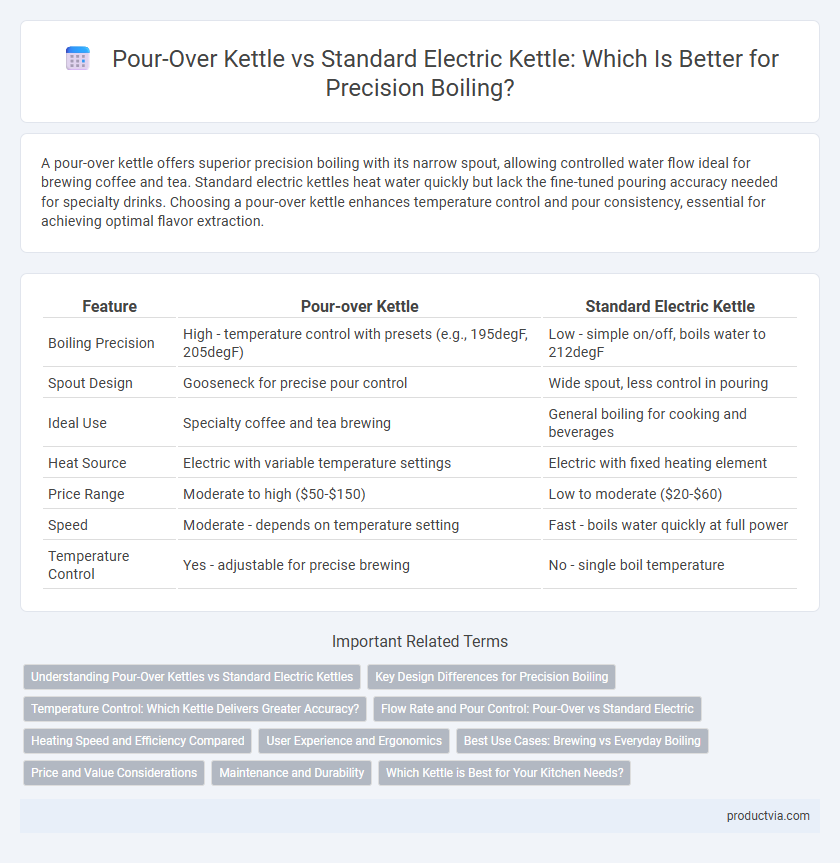A pour-over kettle offers superior precision boiling with its narrow spout, allowing controlled water flow ideal for brewing coffee and tea. Standard electric kettles heat water quickly but lack the fine-tuned pouring accuracy needed for specialty drinks. Choosing a pour-over kettle enhances temperature control and pour consistency, essential for achieving optimal flavor extraction.
Table of Comparison
| Feature | Pour-over Kettle | Standard Electric Kettle |
|---|---|---|
| Boiling Precision | High - temperature control with presets (e.g., 195degF, 205degF) | Low - simple on/off, boils water to 212degF |
| Spout Design | Gooseneck for precise pour control | Wide spout, less control in pouring |
| Ideal Use | Specialty coffee and tea brewing | General boiling for cooking and beverages |
| Heat Source | Electric with variable temperature settings | Electric with fixed heating element |
| Price Range | Moderate to high ($50-$150) | Low to moderate ($20-$60) |
| Speed | Moderate - depends on temperature setting | Fast - boils water quickly at full power |
| Temperature Control | Yes - adjustable for precise brewing | No - single boil temperature |
Understanding Pour-Over Kettles vs Standard Electric Kettles
Pour-over kettles feature a slender gooseneck spout that allows precise control of water flow, essential for even extraction in pour-over coffee brewing. Standard electric kettles prioritize rapid boiling with wider spouts, making them less suitable for controlled pouring but ideal for quick water heating. Understanding the design differences highlights why pour-over kettles excel in precision boiling, while standard electric kettles focus on efficiency and speed.
Key Design Differences for Precision Boiling
Pour-over kettles feature a narrow, elongated spout that allows for controlled, slow pouring essential for precision brewing, while standard electric kettles typically have wider spouts designed for quick filling and pouring. Temperature control is more advanced in pour-over kettles, often equipped with variable temperature settings and high-accuracy sensors to target specific boiling points required for different coffee or tea types. The ergonomic handle and balanced design of pour-over kettles support steady, precise pouring, contrasting with the more utilitarian handles found on standard electric kettles primarily built for general rapid boiling.
Temperature Control: Which Kettle Delivers Greater Accuracy?
Pour-over kettles offer superior temperature control with precise settings typically adjustable in 1-degree increments, ideal for brewing delicate teas and specialty coffee. Standard electric kettles often lack fine-tuned temperature options, providing only basic presets or a simple boil function. For accuracy in precision boiling, pour-over kettles deliver greater temperature consistency and control, enhancing the brewing experience.
Flow Rate and Pour Control: Pour-Over vs Standard Electric
Pour-over kettles feature a narrow, curved spout allowing for precise pour control and a slower, steady flow rate ideal for manual brewing methods. Standard electric kettles typically have wider spouts resulting in faster flow rates but less control over water distribution, making them less suited for tasks requiring precision. For coffee enthusiasts prioritizing accuracy in extraction, pour-over kettles provide superior flow regulation and targeted pouring capabilities.
Heating Speed and Efficiency Compared
Pour-over kettles offer precise temperature control crucial for specialty coffee brewing, utilizing variable heat settings that maintain water within optimal temperature ranges from 140degF to 212degF. Standard electric kettles typically feature a single boil function, heating water rapidly but lacking the fine-tuned temperature precision essential for pour-over techniques. While standard models may heat faster due to higher wattage, pour-over kettles prioritize energy efficiency through controlled heating cycles, minimizing overheating and energy waste.
User Experience and Ergonomics
Pour-over kettles offer superior control over water flow and temperature, enhancing precision for specialty coffee brewing and improving user experience through ergonomic handles and spouts designed for steady pouring. Standard electric kettles prioritize rapid boiling and ease of use but often lack the fine temperature settings and pour control essential for precision tasks. Ergonomically, pour-over kettles reduce wrist strain with lightweight, balanced designs, while standard kettles emphasize convenience and speed without the same level of ergonomic refinement.
Best Use Cases: Brewing vs Everyday Boiling
Pour-over kettles excel in precision boiling with adjustable temperature controls ideal for brewing specialty teas and coffee, ensuring optimal extraction and flavor. Standard electric kettles heat water quickly to boiling point, making them more suitable for everyday tasks like cooking, instant meals, and basic tea preparation. For coffee enthusiasts and tea connoisseurs, a pour-over kettle offers superior control, while standard electric kettles provide efficiency and convenience for general household use.
Price and Value Considerations
Pour-over kettles typically offer superior precision boiling with adjustable temperature controls, ideal for coffee enthusiasts but often come at a higher price point ranging from $50 to $150. Standard electric kettles, priced between $20 and $60, provide quick boiling but lack temperature customization, making them more cost-effective for general use. Value considerations depend on the need for precise temperature settings versus budget constraints, where pour-over kettles justify their premium through enhanced brewing accuracy.
Maintenance and Durability
Pour-over kettles typically feature stainless steel or copper gooseneck spouts designed for precise pouring and often require regular descaling to maintain optimal performance. Standard electric kettles usually have larger capacities with concealed heating elements, making them easier to clean and more resistant to mineral buildup. Durability varies by brand, but inox materials in pour-over models tend to withstand frequent use longer, while standard electric kettles balance robustness with convenience and less intensive upkeep.
Which Kettle is Best for Your Kitchen Needs?
A pour-over kettle offers precise temperature control and a narrow spout for controlled water flow, making it ideal for coffee and tea aficionados who prioritize accuracy. Standard electric kettles typically boil water quickly but lack the fine temperature adjustments and pouring precision needed for specialty brews. Choosing the best kettle depends on your kitchen needs: opt for a pour-over kettle for precision brewing or a standard electric kettle for fast, straightforward boiling.
Pour-over kettle vs standard electric kettle for precision boiling Infographic

 productvia.com
productvia.com